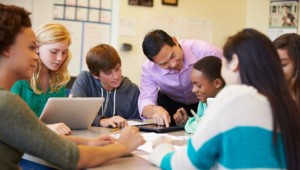How to Create Experiences and Scale Environments That Change Lives

Dan Leeser enjoys the creative work of designing his own projects. In the fall, his students at Franklin Cougar New Tech in El Paso created graphic novels that combined Greek myths with Asian culture–an interesting thought experiment that encouraged students to consider the role of myth in society in the past and the present. Interesting projects keep student and teacher engagement high.
“This environment is vastly different from my last school,” said Dan. He said it required some comfort with risk and ambiguity. He appreciates that campus and district administration are comfortable with lesson experimentation.
Dan’s colleague Sarah Dominguez teaches math. Like many teachers in the New Tech Network, she uses a hybrid of existing, adapted and self-created lessons. She appreciates the quick tutorials that keep project teams moving. New Tech teachers like Dan and Sarah benefit from startup support, on-site coaching, online resources and an annual conference.
Sarah and Dan are co-founders of a new academy that is part of a platform network: a group of schools that share learning goals, an approach to learning, common tools and systems, and an adult learning community where improvement thrives.
New Tech Network is one of the largest and best examples of a platform network. It is a network of voluntary associations including partnerships with 118 public school districts in 29 states. With its focus on project-based learning, it is one of the best examples of co-creation on a common platform.
Other voluntary networks of like-minded schools include the 716 NAF career academies, more than 150 Expeditionary Learning schools and more than 50 Big Picture Learning schools.
Key Ingredients
 Successful learning networks share four elements: vision, learner experience, teacher experience and tools.
Successful learning networks share four elements: vision, learner experience, teacher experience and tools.
Vision: Every successful learning institution or initiative starts with clear goals. For New Tech Network, it’s a vision of “a nation proud of its public schools” and a set of student learning outcomes: knowledge and thinking, written and oral communication, agency and collaboration (below).
Learner Experience (LX): Networks share a common approach to supporting powerful learner experiences and learning resources including content, tasks and assessments (what we used to call curriculum). Successful networks shared values, an advisory system and youth and family support services. Powerful learning experiences are supported by school or program structures, schedules and staffing strategies that support learning.
Tools: Scaled learning networks typically share tools. In our review of learning platforms, we found that many forward-leaning districts and school developers want a platform that:
- Powers and tracks personal learning plans;
- Manages assignments and dynamic grouping;
- Supports development of standards-aligned projects;
- Makes it easy to combine proprietary, open, district and teacher-developed content;
- Combines formative assessments in a standards-based grade book;
- Incorporates social, collaborative, productivity and presentation tools;
- Integrates with other systems, provides single sign-on for lots of apps; and
- Connects students, parents and teachers anywhere on any device.
Going forward, platforms will optimize for mobile, incorporate smart recommendations and support social emotional learning (and increasingly, wellness). Platform tools sit in an IT stack that extends from student information systems to student access devices.
Teacher Experience (TX): Learning networks create great conditions and supports that allow them to be successful. Strong networks offer comprehensive designs and supports but leave room for teachers to innovate and pilot new approaches. Successful networks support just-in-time personalized learning and track professional growth often using microcredentials and portfolios.
Networks share a framework for improvement and innovation. “School leaders need to focus their attention on creating the conditions where teachers have the resources, courage and support to experiment with improving their practice, and then the space to share what they are learning with other educators,” said Justin Reich, executive director of the MIT Teaching Systems Lab.
The improvement framework for the New Tech Network (left) incorporates shared values, process tools and common structures. New Tech and NAF are networks of voluntary association. Managed networks were purpose-built around a shared vision and, like school districts, hold governance, operation and employment responsibility.
Managed Networks
Most charter management organizations (CMO) launched after 2010–such as Alpha, DaVinci and Thrive–were built from scratch as platform networks. These managed networks share a school model, toolset and support services. Connections Academy and K12 support national networks of virtual schools–another example of platform networks.
Older CMOs including Achievement First, Alliance of College Ready Public Schools, Aspire, Charter Schools USA, Harmony and IDEA, have adopted platforms and next generation learning models.
Summit Public Schools is a learning network in two respects. It operates an innovative network of secondary schools that combines personalized and project-based learning (see 10 innovative features) and they support a voluntary network of more than 100 school teams in the Summit Learning program. Like schools in Summit’s CMO, Summit Learning schools share the same student learning goals (below), curriculum and assessment, learning platform, in-person professional development and ongoing teacher support.
Districts as Platform Networks
Some school districts, particularly smaller ones, operate like learning networks with a common learner experience, a shared platform and information systems, and aligned support systems. I call this an enterprise approach—everybody using the same strategies and systems. The other approach is a portfolio of schools, each with a unique model and customized supports (for example, see feature on Denver).
North Carolina’s Mooresville Graded School District pioneered a distributed leadership approach to their district-wide digital conversation.
Middletown City School District (northwest of NYC) used a Race to the Top grant to implement a blended learning model with help from EdElements. Teachers and students focus on goal setting (see a post from superintendent Dr. Kenneth W. Eastwood).
Mentor Schools, east of Cleveland, is another EdElements partner. Like Summit, they are sharing tools and lessons across the Ohio Blended Learning Network with help from a state Straight A grant.
Milpitas School District, north of San Jose, is making progress on blended learning using a lab rotational model and experimenting with mixed age grouping and other new models (see Christensen Institute district feature and two school profiles featuring i-Ready).
A growing number of districts are adopting blended and competency-based learning models where students progress based on demonstrated mastery. Leaders include Chugach Alaska, Linsday USD in southern California, RSU2 in Maine, Sanborn in New Hampshire, Lake County Schools in Florida, and Colorado’s Adams 50 (these links go to CompetencyWorks features; watch for a series on Mesa County, Colorado, starting later this month).
Curriculum Networks
Expanding course access (part time access to online and blended courses) has created a growing number of curriculum networks–quality courseware on a robust platform with professional learning supports.
Project Lead The Way supports hands-on computer science, engineering and biomedical science experiences, K-12 with content (on the Canvas platform) and associated professional development (see feature).
Apex Learning provides secondary education courses, tutorials, implementation support and professional development (see feature). Fuel Education provides online secondary courses through the Peak platform (see feature).
Why Networks Matter
Millions of American teachers work hard to personalized learning for every student every day. But in many schools, they are doing it without the support of a system. They don’t benefit from a fully aligned system designed for their success.
Personalized learning models are challenging to build. Competency-based progressions add to the challenge and require a high degree of team coordination and new forms of student, teacher and school support. Developing or adapting platform tools to a learning model is a big technical challenge. Add talent development demands and you have a trifecta that is daunting for even the most experienced teams. It doesn’t make sense for individual schools to attempt to develop a learning model, platform and professional development system. The do-it-yourself approach is hard for one school and it’s not sustainable or scalable across a system.
Smaller school districts, like those discussed above, can develop a coherent and dynamic system–one that guarantees powerful learning experiences for students and supports teacher innovators. Most districts will require one or more technical assistance partners, at least periodically, to develop their own network formula.
Like Denver, larger districts typically support multiple networks and scale those that are working best for students. Personalized and project-based learning holds great promise but we shouldn’t assume that individual teachers or even experienced school teams can figure all this out on their own. They should have the opportunity to join like-minded schools in networks where they can co-create powerful learning experiences, participate in professional learning opportunities, and benefit from a platform that improves over time.
This blog is part of a multi-year campaign studying networks and their effect on education and transformation. Our work will culminate in a book publishing in 2018. Learn more and join the conversation using #NetworkEffect.
For more see:
- Two Strategies for Empowering Teacher Leaders (enterprise or portfolio)
- How School Networks Work and Why That’s Important
- Structures Drive Behaviors: Right is Magic Wrong is Deadly
Stay in-the-know with all things EdTech and innovations in learning by signing up to receive the weekly Smart Update. This post includes mentions of a Getting Smart partner. For a full list of partners, affiliate organizations and all other disclosures please see our Partner page.







0 Comments
Leave a Comment
Your email address will not be published. All fields are required.